Endless Variations
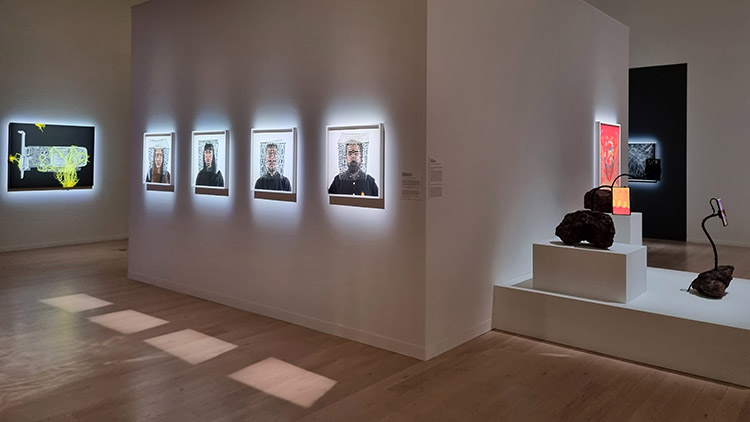
Canadian Cultural Center, Endless Variations, 2023-24.
The world accelerated as one industrial revolution after another produced societal and aesthetic changes. It was in the 19th century that the serial treatment of subjects became widespread in painting, as if to better grasp every aspect of them. In an age of unbridled use of artificial intelligence algorithms in industry and art alike, it is more appropriate to approach many works through their multiple versions. Increasingly, artists are literally collaborating with programs capable of generating their works in infinite variations. When the results are striking, it is up to them to interrupt the autonomous processes they had initiated. But what has been new in recent years is that we can all use such interfaces to, for example, refine our multiple online profiles. In this way, we have a certain closeness to the creations that come out of iterative or generative processes. The exhibition Endless Variations of the Canadian Cultural Center that is in the program of the Nemo Biennale should be seen as a studio where the artworks are in the process of being made.
Such beauty

Alain Thibault, Apollo 11 Dream, 2023.
The exhibition Endless Variations opened at the Canadian Cultural Center in Paris with an audiovisual performance by Alain Thibault. Entitled Apollo 11 Dream, it is punctuated by the beeps that recall July 21, 1969, the day of the moon landing, when exchanges were punctuated by strident sounds symbolizing distance forever. Synthesized voices declaim the words of the two astronauts, while the rotating Moon rarely leaves our field of vision. It's only when Houston's voice repeats itself, as if there were a bug in the mission, that we grasp the force of the disturbances in both images and sounds. From that very moment, this performance extracts us from a historical reality to offer us alternatives enriching our imaginations. « It's different but it's very pretty out here », exclaims one of the two explorers. But what is this otherworld of such beauty that mankind seems to have been "protecting" itself since 1972, when American astronauts trod the lunar dust for the last time?
The political body

Chun Hua Catherine Dong, Skin Deep, 2019.
Chun Hua Catherine Dong uses photography to bear witness to performances in which she asserts the political aspect of the body, as in her series of prints entitled Skin Deep. Posing in front of the camera, she masks her face with Chinese silk fabrics embellished with gold or silver embroidery. As a result, her tight framing, which usually establishes identity, no longer reveals any. Through this series, the artist aims to draw attention to the culture of shame in the Far East. Many countries in the past and even today, notably China, have installed such a feeling to better control their citizens. In Western societies, however, guilt is still the order of the day. In any case, the woman's body, also because of its resistance in contemporary societies, appears more political today than ever. Note: a mobile application can be used to deliver the visual and animated messages that lie dormant on the surface of such faces, intentionally deprived of identities.
Fragments of cultures
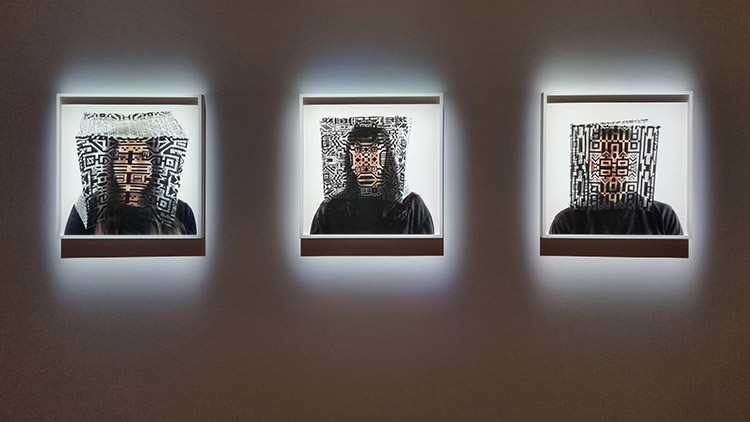
Caroline Monnet, Fragment series, 2019.
Caroline Monnet is a multidisciplinary artist of Franco-Anishinaabe (Algonquin) origin who lives and works in Montreal. Particularly sensitive to North America's first nation cultures, she regularly invokes them in her work, as in her series of portraits entitled Fragment. The cubic masks she has made feature patterns handed down from generation to generation. From a formal point of view, the symmetrical compositions with their interlaced geometries are perfectly suited to the faces of the subjects photographed. From a symbolic point of view, the graphics, which alter the recognition of faces, act as filters, like our beliefs, which often interfere with our relationships with others. These screens placed by the artist between self and other in the space of an exhibition can only encourage us to reconsider our judgments. The fragments of cultures from which we come, because they complement and overlap in one way or another, should always bring us together.
The depth of the image
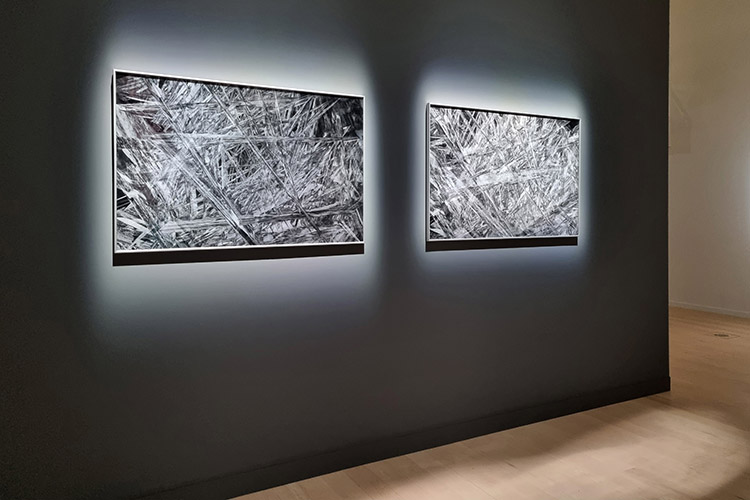
Georges Legrady, Anamorph-Lattice, 2020-2022.
The Anamorph-Lattice series is made up of lenticular panels which contain as many representations as there are viewpoints in the exhibition space. Even standing still, we perceive the depth of these images, initially composed of carefree family photographs taken in Hungary in 1940, as the world sank inexorably into war. Georges Legrady multiplied these pre-horror photographic moments by arranging them within the virtual three-dimensional space of an application he developed based on the model of mathematician Georgi Voronoi. Compressed that way, they evoke the history of representation in painting, and we inevitably think of Hans Holbein the Younger's Ambassadors. Their assemblages appear infinite in terms of possibilities, but the artist has captured only a few of them. The generative compositions that emerge are resolutely abstract, although the tangles of peaks that abrade our retinas evoke the crystals found in Mexico's Naïca caves, while their texture recalls the wood marquetry of Italian Renaissance perspective painters.
Transparency and opacity
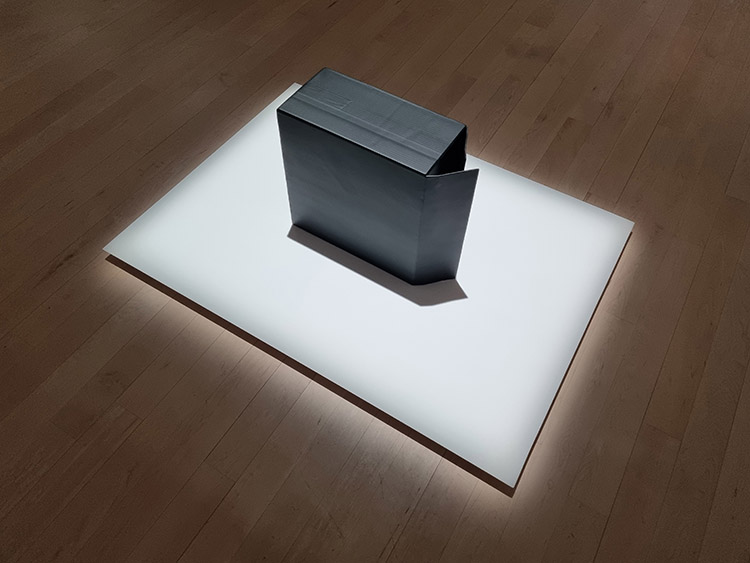
Nicolas Baier, Black Box, 2022.
The Black Box installation, consisting of a black monolith resting on a white plinth, looks like a piece of minimal art. But it is more a tribute to the contemporary complexities of the invisible, considering what it represents. For Nicolas Baier has modeled all the components of a computer tower like those used by gamers, then printed them out in three dimensions, assembled them and finally (re)placed this simulacrum of a machine in a half-opened black cardboard box. Magnified in this way, and with its invisible side symbolizing the opacity of artificial intelligence algorithms, the computer is none other than the subject of the work. The X-ray-like prints from the Replication series that accompany the sculpture are tantamount to a certificate of meticulous reconstitution. As for the yellow filamentary network resembling a blob, that unicellular species without a brain yet capable of many feats, it seems to contaminate the images. At the same time, it evokes the complexity of the living, with which our machines are constantly competing.
The place of emergence
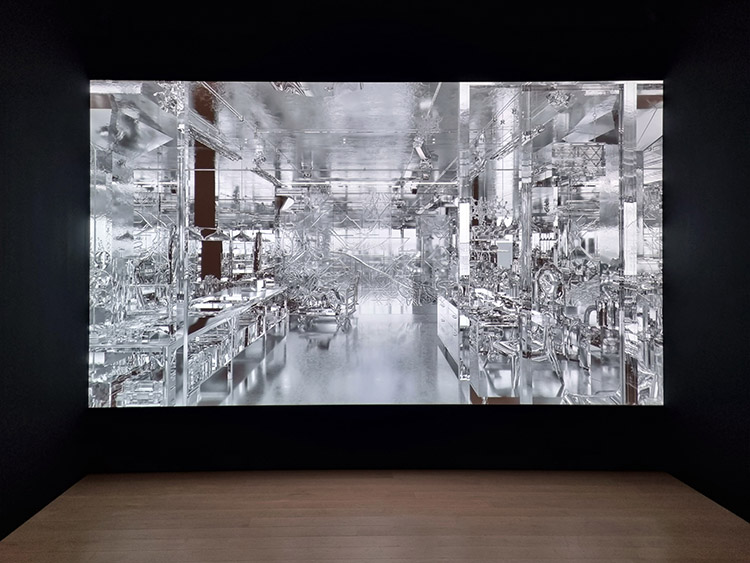
Nicolas Baier, Vases communicants, 2023.
Many painters have depicted their studios, but few artists, like Nicolas Baier, have done it this way. Baier has modeled the place of emergence of his creations without omitting a single detail or object. The glittering atmosphere that emerges evokes the gold-leaf gilding the ancients reserved for the divine. It's often said that tubes of color freed Impressionist painters from their studios, but today it's three-dimensional applications that have kept Nicolas Baier there. Even when it comes to generating the undergrowth for the continuation of his sequence entitled Vases communicants, and thus striking a balance between architecture and nature, interior and exterior, without ever straying far from his computer. The latter is his real studio, the ultimate place of making, with infinite possibilities in terms of both points of view and frames, among other recurring notions from art history. Even the glimmering stars symbolize the unattainable rather than the distant, in the context of space travel that slowly swallows up time.
Nature and technology
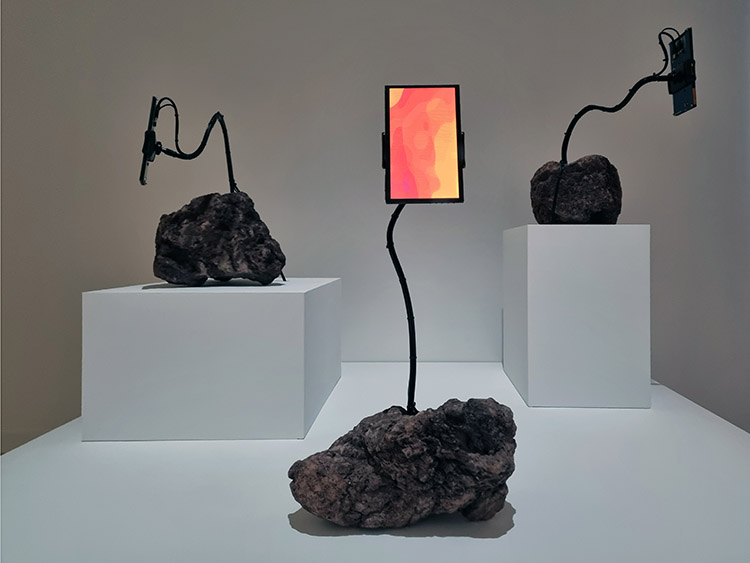
Nicolas Sassoon, The Prophets, 2019.
The sculptures in Nicolas Sassoon's The Prophets series are assemblages of volcanic rocks and screens. The fact that the artist has placed his boulders on plinths gives them a museum-like presence. The animations played on screens to which they are connected evoke the magmatic origin of the ejecta. Such an association of the mineral and the technological inevitably refers to the extraction of rare-earth elements, essential to the manufacture of our electronic devices and the data centers to which they are connected. Not to mention that the contortions of the rods that connect the stones to the screens give them a kind of "character". But what could they be prophesizing in this geological epoch of the Anthropocene, when it is now humans who are shaping the Earth with the aid of technology? Except that the technology could well be on the side of poison as well as remedy - what we call in Greek the “pharmakon” - as the philosopher Bernard Stiegler foresaw.
Industrial revolutions
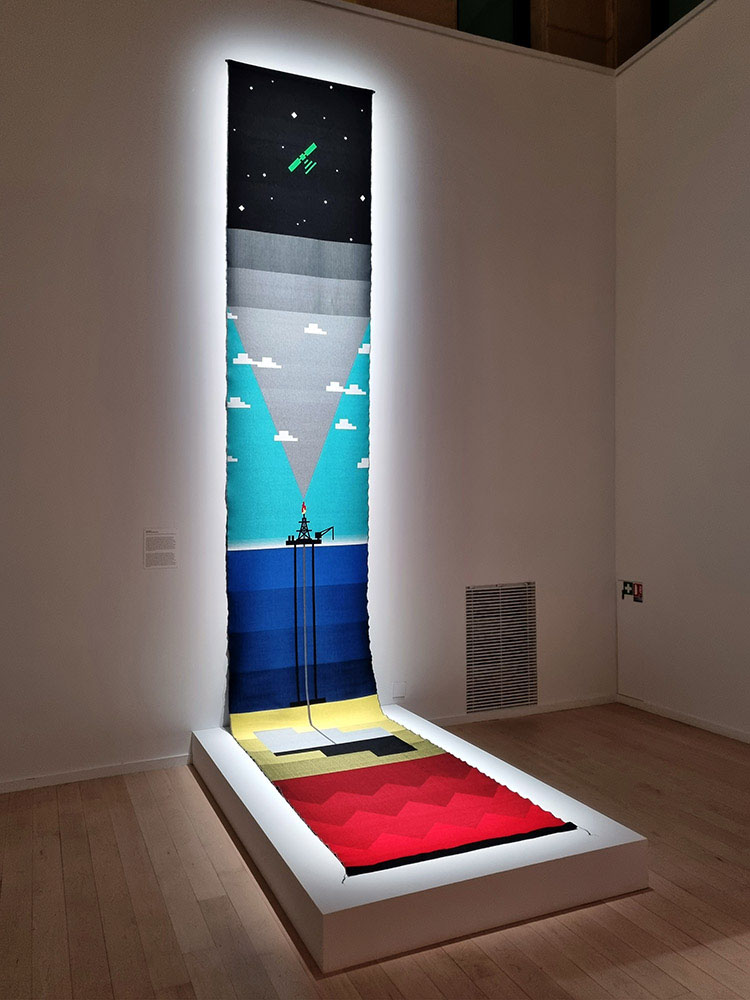
Oli Sorenson, Plate-forme pétrolière, 2023
The Panorama of the Anthropocene series lists the human activities that are permanently altering the geology of our planet and its ecosystems. This enumeration, initiated by Oli Sorenson during the last pandemic, is resolutely graphic. Industries such as digital technology, whose devastating impact on the environment is well known, are symbolized by colored pictograms. The format is that of the square that abstract painters like Peter Halley love to experiment with, and which satisfies content creators on Instagram. New to the artist's series are tapestries made on looms. The loom developed by Joseph Marie Jacquard in 1801 was the first mechanical system to be programmed using punched cards. In the 1830s, this was followed by the Luddite revolts, whose jobs were threatened by automation. No doubt they eventually adapted, just as today's manufacturers must reinvent themselves confronted with artificial intelligence and climate change.
With an exhale
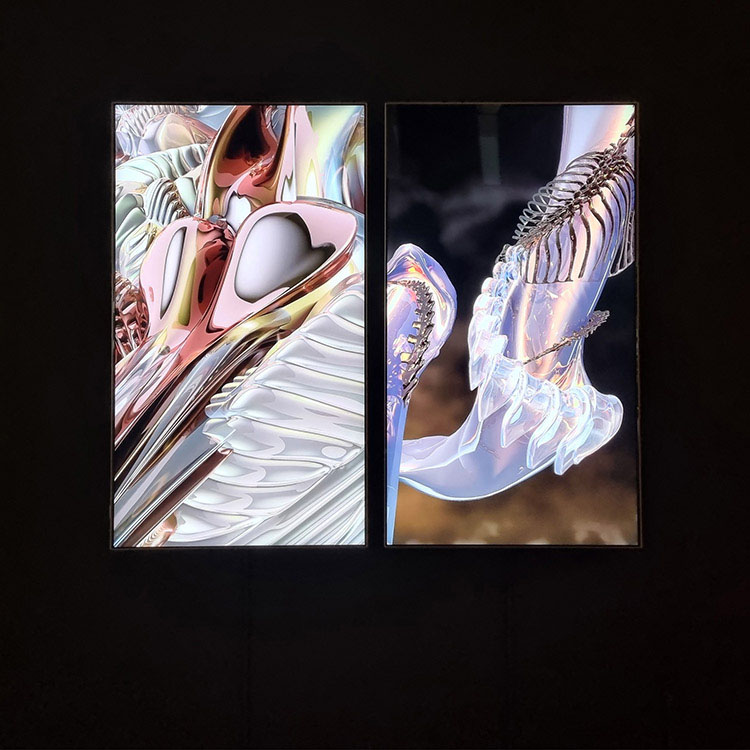
Salomé Chatriot, Breathing Patterns (Luma), 2023.
While we were all holding our breath in 2020 due to the pandemic, Salomé Chatriot recorded her breathing during a performance while lying on a tree trunk. In 2021, she used her respiratory data in two 3D sequences from the Breathing Patterns series, which she repeated for each performance. In 2023, she hyperventilated in the snow at high altitude. The two video screens allow us to visualize different rhythms translating distinct emotional states. Where the chaos of irregular breathing, from side to side, dissipates to give way to that which expresses serenity. Her "organs", which in no way correspond to the idea we have of our respiratory systems, appear as extensions of the artist's body, as she virtually continues her performance. It's as if she has delegated her breath, an expression of intimacy, to the technical objects that artificially prolong her. Contrary to what happened in 2020, when artificial devices assisted humans, the artist breathes life into synthetic organs.
Post digital painting
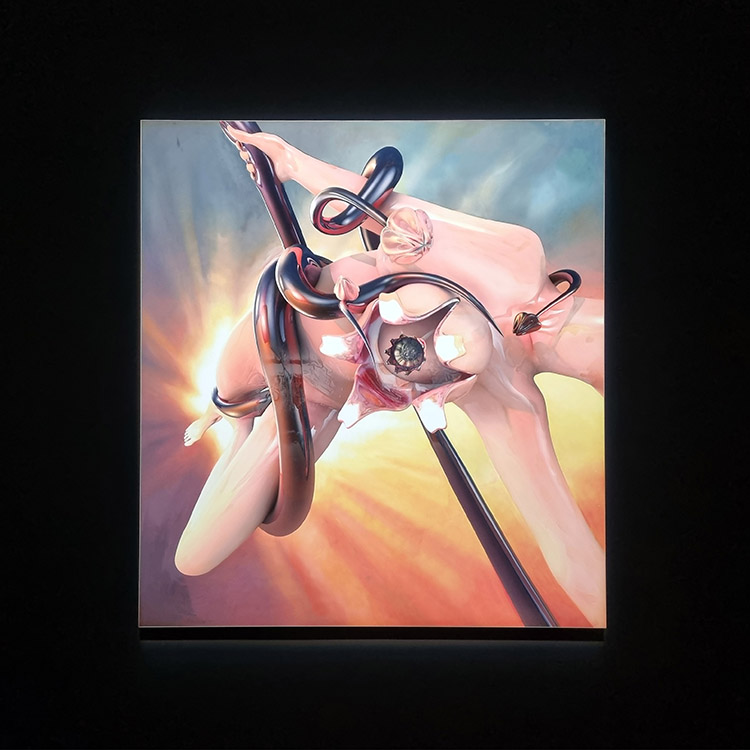
Salomé Chatriot, Idol (Hydra 4), 2023.
Salomé Chatriot is an artist whose multiple, sometimes intersecting disciplines are all about the body, from sculpture to interactivity, from painting to three dimensions. Her series of enamel paintings of bodies or body fragments on aluminum - human or non-human - particularly crystallize this aesthetic of passage emblematic of her work, as they are pictorial representations that appear to be truly post-digital. The reflections afforded by enamel summon the artificial light of 3D applications. As a result, we no longer observe images as our predecessors of the pre-CGI era did. Salomé Chatriot's aesthetic participates in a form of post-painting that we've become accustomed to because it’s similar to the idea of a post-photographic trend in art. Her gesture is ample, although she exercises meticulous control over the luminous ambiances reflected on the surfaces of her models, the exact nature of which we don't know.
Those who enter the image

Christa Sommerer & Laurent Mignonneau, People on the Fly, 2016.
People on the Fly by artists Christa Sommerer & Laurent Mignonneau is a closed-circuit video aparatus that the audience activates by its presence. The interactive installation behaves like a mirror, with one difference: the colors are desaturated, as if to signify that it's not quite reality. This is confirmed when the artwork's camera detects a presence in the exhibition space. Those who enter the image are assaulted by swarms of virtual flies. The spectacle of life played out on the surface of this video installation encourages participants to interact according to different strategies. Some remain motionless, literally disappearing, while others try to attract the insects or hope to avoid them, but to no avail. The true subject of this open-ended artwork is the audience itself, which completes it, if not completes it by its mere presence.
Endless wandering
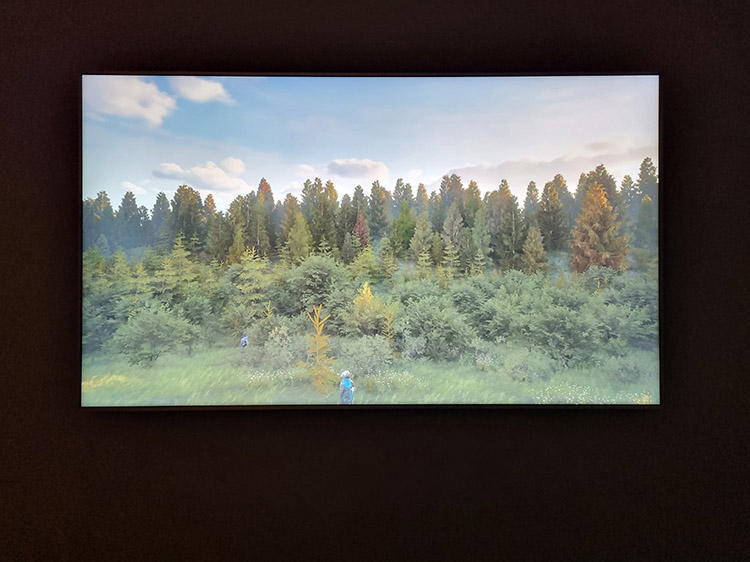
Timothy Thomasson, I’m Feeling Lucky, 2023.
Timothy Thomasson has created the universe of the generative installation I'm Feeling Lucky using a game engine including the laws of physics. He has thought out every detail, which the machine computes before our very eyes in real time. He's familiar with the panoramic practices of nineteenth-century painters and photographers, which the video game industry has reactivated in this digital age. And when he wanted to populate his infinite landscape, he turned to Google Street View, which archives our world to create a panoramic double. In other words, the artist extracted the photographic silhouettes of ordinary people to increase their three-dimensional presence, before positioning them precisely in their new territory, as one would patiently do with figurines. In this way, the post-cinematographic scene that slowly unfolds before our eyes tells the story of what didn't happen. The protagonists of what's being played out probably don't even know they're taking part in this creation of an endless wandering.
Articles
- Paris Photo
- Art, technology and AI
- Immersive Art
- Chroniques Biennial
- 7th Elektra Biennial
- 60th Venice Biennial
- Endless Variations
- Multitude & Singularity
- Another perspective
- The Fusion of Possibilities
- Persistence & Exploration
- Image 3.0
- BioMedia
- 59th Venice Biennale
- Decision Making
- Intelligence in art
- Ars Electronica 2021
- Art & NFT
- Metamorphosis
- An atypical year
- Real Feelings
- Signal - Espace(s) Réciproque(s)
- On Combinations at Work
- Human Learning
- Attitudes and forms by women
- Ars Electronica 2019
- 58th Venice Biennale
- Art, Technology and Trends
- Art in Brussels
- Plurality Of Digital Practices
- The Chroniques Biennial
- Ars Electronica 2018
- Montreal BIAN 2018
- Art In The Age Of The Internet
- Art Brussels 2018
- At ZKM in Karlsruhe
- Lyon Biennale 2017
- Ars Electronica 2017
- Digital Media at Fresnoy
- Art Basel 2017
- 57th Venice Biennial
- Art Brussels 2017
- Ars Electronica, bits and atoms
- The BIAN Montreal: Automata
- Japan, art and innovation
- Electronic Superhighway
- Lyon Biennale 2015
- Ars Electronica 2015
- Art Basel 2015
- The WRO Biennale
- The 56th Venice Biennale
- TodaysArt, The Hague, 2014
- Ars Electronica 2014
- Basel - Digital in Art
- The BIAN Montreal: Physical/ity
- Berlin, festivals and galleries
- Unpainted Munich
- Lyon biennial and then
- Ars Electronica, Total Recall
- The 55th Venice Biennale
- The Elektra Festival of Montreal
- Digital practices of contemporary art
- Berlin, arts technologies and events
- Sound Art @ ZKM, MAC & 104
- Ars Electronica 2012
- Panorama, the fourteenth
- International Digital Arts Biennial
- ZKM, Transmediale, Ikeda and Bartholl
- The Gaîté Lyrique - a year already
- TodaysArt, Almost Cinema and STRP
- The Ars Electronica Festival in Linz
- 54th Venice Biennial
- Elektra, Montreal, 2011
- Pixelache, Helsinki, 2011
- Transmediale, Berlin, 2011
- The STRP festival of Eindhoven
- Ars Electronica repairs the world
- Festivals in the Île-de-France
- Trends in Art Today
- Emerging artistic practices
- The Angel of History
- The Lyon Biennial
- Ars Electronica, Human Nature
- The Venice Biennial
- Nemo & Co
- From Karlsruhe to Berlin
- Media Art in London
- Youniverse, the Seville Biennial
- Ars Electronica, a new cultural economy
- Social Networks and Sonic Practices
- Skin, Media and Interfaces
- Sparks, Pixels and Festivals
- Digital Art in Belgium
- Image Territories, The Fresnoy
- Ars Electronica, goodbye privacy
- Digital Art in Montreal
- C3, ZKM & V2
- Les arts médiatiques en Allemagne
- Grégory Chatonsky
- Le festival Arborescence 2006
- Sept ans d'Art Outsiders
- Le festival Ars Electronica 2006
- Le festival Sonar 2006
- La performance audiovisuelle
- Le festival Transmediale 2006
- Antoine Schmitt
- Eduardo Kac
- Captations et traitements temps réel
- Maurice Benayoun
- Japon, au pays des médias émergents
- Stéphane Maguet
- Les arts numériques à New York